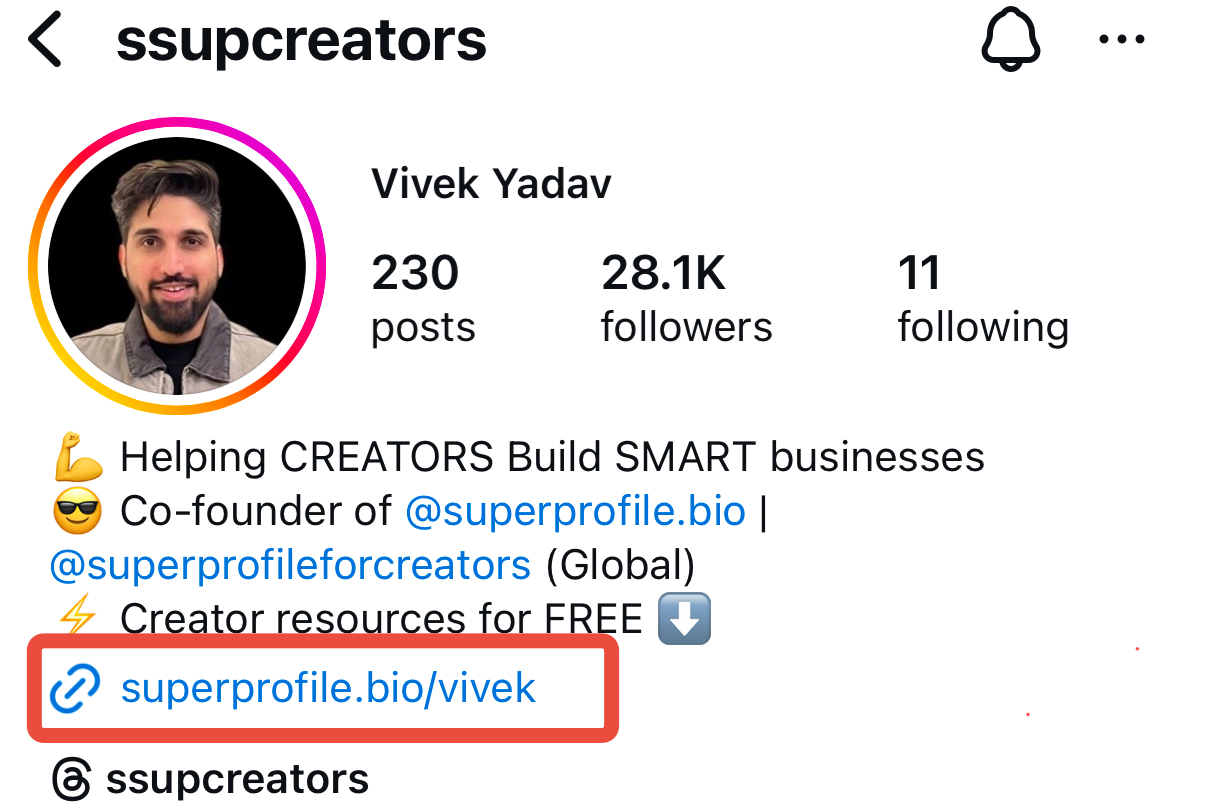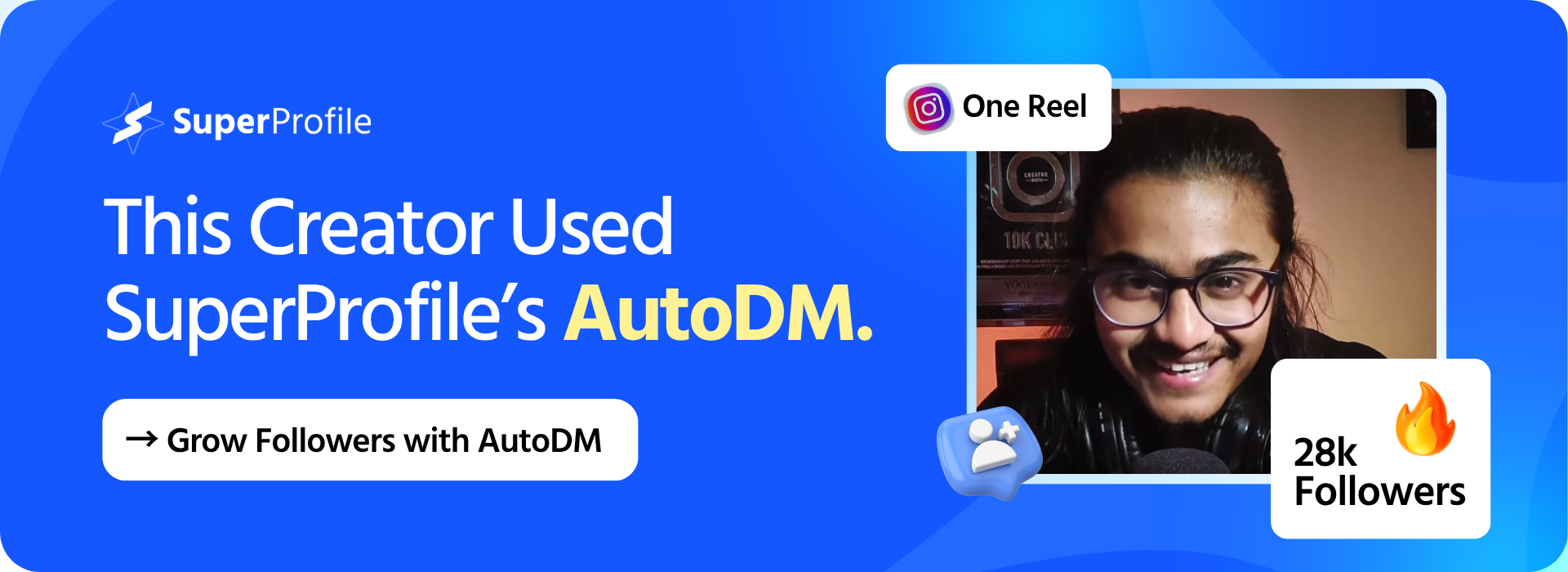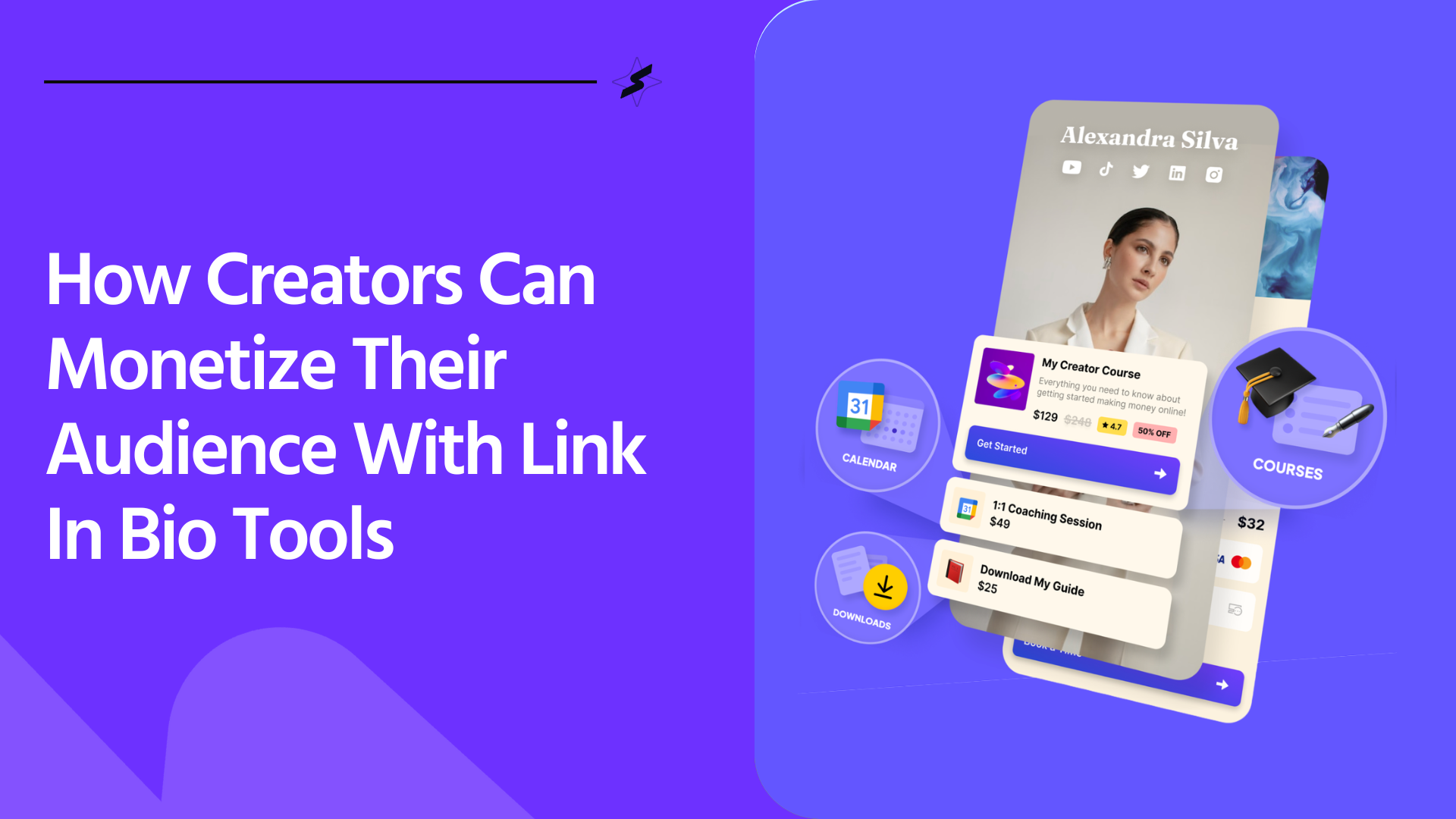For creators who publish content on social platforms like Instagram or TikTok, growing an audience is often the first step. Turning that attention into sustainable income is the next challenge.
Many creators rely on limited digital real estate—one clickable link in their bio—to direct followers to other content, products, or services. This single link becomes a central tool for sharing more than what's possible in individual posts.
This article explains how creators use "link in bio" tools to organize their offerings, increase engagement, and monetize their audiences across different channels.
What Is A Link In Bio And Why Does It Matter
A "link in bio" is a single clickable URL found in a social media profile, typically at the top of the page. It allows the account owner to direct followers to another webpage or a collection of links.

Most social platforms, including Instagram and TikTok, don't allow users to add clickable links in captions or comments. This limitation makes the profile bio the only place where a working URL can consistently be shared.
Because of this restriction, the link in bio becomes a valuable tool. It acts as a traffic funnel, helping creators move their audience from social media to destinations like stores, newsletters, or booking pages.
Key benefits of a link in bio:
- Central hub: A link in bio page can include multiple links, allowing creators to direct followers to various resources from one URL
- Platform independence: Since the link directs to external content, creators can build relationships beyond the social platform
- Analytics access: Many link in bio tools offer performance metrics that help creators understand what their audience engages with
How A Single Bio Link Drives Traffic And Engagement
When someone visits a creator's profile on social media, the link in bio is often the first step in a path toward taking action—such as signing up for a newsletter or purchasing a product. This journey typically begins with curiosity sparked by a post, followed by a visit to the profile, a click on the bio link, and finally, interaction with the linked content.
The page that opens after clicking the bio link is often called a micro-landing page. It's a lightweight webpage with a focused layout that presents the most relevant links or actions in one place. Because it's optimized for mobile viewing and fast navigation, it helps users quickly find what they're looking for.
The follower-to-customer path typically looks like this:
- Follower sees a post or story
- Follower clicks the profile
- Follower taps the bio link
- Micro-landing page opens
- Follower clicks a specific offer or call-to-action
- Follower completes a transaction, sign-up, or view
Earlier versions of link in bio tools were simple lists of links. Today, these tools have developed into full monetization platforms, offering features like storefronts, course hosting, and payment integration—all accessible from a single link.
Essential Ways Creators Monetize With Link In Bio Tools
Modern link in bio tools allow creators to offer multiple types of products and services using a single link. This link typically leads to a page with buttons or sections for different monetization options. These tools remove the need to build separate websites and help consolidate sales and engagement in one place.
Digital Product Sales
Digital products are files that can be sold and delivered electronically. These include eBooks, templates, design presets, audio files, and digital courses.
Link in bio tools allow creators to sell digital products directly from their micro-landing page. This makes it possible to sell without setting up a traditional store or paying for a separate website.
Pricing for digital products depends on the product's complexity and the creator's audience. Common pricing strategies include fixed prices, bundles, and pay-what-you-want models. Since there are no shipping or manufacturing costs, profit margins are typically high.
Popular digital product examples by niche:
- Fitness: meal plans, workout guides
- Photography: Lightroom presets, posing guides
- Education: study templates, lesson PDFs
- Business: invoice templates, Notion dashboards
- Art: printable wall art, coloring books
Affiliate Marketing Commissions
Affiliate marketing is a method where creators earn a commission when someone buys a product using their referral link. The creator doesn't handle the product or the transaction but promotes items through their content.
To use affiliate marketing in a bio link, creators add buttons or text that link to affiliate products. When followers click and buy, the creator receives a commission.
Creators are required to disclose affiliate links to follow advertising guidelines. This can be done by adding a short note like "affiliate link" or "sponsored" near the link.
Basic comparison of affiliate programs:
Coaching And Consulting Services
Coaching and consulting services are 1:1 sessions where a creator provides personalized guidance or support. These services are often promoted through a creator's link in bio.
Creators list available services and allow followers to book calls directly through the bio link. Sessions can be priced per hour, per package, or by subscription. Calendars can be integrated to avoid double-booking and to automate scheduling.
Testimonials from previous clients can be added to the landing page to build trust. These may include short quotes, video clips, or screenshots of positive feedback.
Effective service descriptions might include:
- "30-Min Instagram Growth Strategy Session"
- "1-Hour Nutrition Consultation"
- "Portfolio Review for Creative Freelancers"
- "Weekly Accountability Check-In"
- "Business Coaching for Etsy Sellers"
.png)
Membership Or Subscription Offers
Memberships and subscriptions give followers access to ongoing content or services in exchange for recurring payments. This model creates predictable monthly income.
Creators often offer tiered pricing levels with different perks. For example, a $5 tier may include early access to content, while a $20 tier might include monthly Q&A sessions or exclusive digital downloads.
Content gating allows creators to limit access to paying members. This may include private podcast episodes, behind-the-scenes videos, or members-only newsletters.
Examples of creator membership offerings:
- A writer offering weekly essays to subscribers
- A music producer sharing exclusive beats and samples
- A wellness coach providing private group coaching
- A digital artist offering early access to prints and tutorials
Choosing The Right Link In Bio Platform
Different link in bio platforms offer different features, pricing models, and levels of customization. Some are simple link lists, while others include storefronts, analytics, and payment capabilities. The right choice depends on what a creator wants to accomplish, especially if monetization is a primary goal.
Here is a comparison of several commonly used link in bio platforms:
When selecting a platform, creators often consider specific features that align with their goals, such as:
- Selling digital products directly
- Offering exclusive content through memberships
- Booking 1:1 services or consultations
- Tracking affiliate link performance
- Hosting events or webinars
Payment integration is another consideration. Some platforms connect to Stripe or PayPal for processing transactions. This allows followers to pay securely through a mobile-optimized checkout experience.
Mobile optimization is important because most traffic from social platforms comes from smartphones. A page that loads quickly and works well on smaller screens can improve the user experience and reduce drop-off.
Strategies To Convert Followers Into Paying Customers
Having a link in bio tool with monetization features is helpful, but the tool alone doesn't create revenue. Strategy—how the tool is used—matters just as much. Here are three common strategies creators use to increase conversions from their bio link.
Optimize Calls To Action
A call to action (CTA) tells visitors exactly what to do next. Effective CTAs are short, clear, and specific. In a link in bio, CTAs often appear as buttons or short text labels.
High-converting CTA examples:
- "Download My Free Guide"
- "Book a 30-Min Call"
- "Shop My Presets"
- "Join My Monthly Membership"
Color and placement influence how often visitors click. Brighter colors like orange or green tend to attract attention. Placing your primary CTA near the top of your page increases visibility.
Before/after example:
- Before: "Click here"
- After: "Get the Free Checklist"
Promote Exclusive Offers
Exclusivity encourages people to act quickly. When followers believe an offer is limited or only for a select group, they are more likely to click and convert.
Limited-time offers are one way to use this strategy. These can include flash sales, free bonuses for early buyers, or discounts that expire after a specific date.
Effective exclusive promotion examples:
- "Available for 72 Hours Only"
- "First 50 Buyers Get a Bonus Template"
- "Pre-Sale Access for Subscribers Only"

Use Social Proof In Your Link
Social proof is information that shows others have used, trusted, or benefited from what is being offered. It helps followers feel more confident in taking the same action.
This can include testimonials, reviews, follower counts, or endorsements from known individuals or brands. On a link in bio page, these can be added as quotes, screenshots, or embedded video clips.
Examples of social proof:
- "Over 1,200 downloads"
- "As seen in Forbes"
- "Reviewed by 300+ students"
- "What clients are saying: [testimonial]"
Building An Email List And Community For Recurring Revenue
Email list building continues to be important even though creators often use social media to reach their audience. Social platforms limit how and when followers see content. Algorithms control visibility, and accounts can be restricted or removed. An email list gives creators a direct way to reach their audience without depending on a platform.
Link in bio tools can help collect emails by offering something called a lead magnet. A lead magnet is a free resource offered in exchange for an email address. This resource is usually related to the creator's content or expertise.
Examples of lead magnets by creator type:
- Fitness creator: "5-Day Meal Plan PDF"
- Photographer: "Free Lightroom Preset"
- Musician: "Exclusive Song Download"
- Coach: "Mini Goal-Setting Workbook"
- Educator: "Printable Study Guide"
The lead magnet link is placed in the creator's bio page. When a follower clicks the link, a simple form collects their email before giving access to the free resource. Some tools also allow automated emails to be sent after a subscriber signs up.
Beyond email, creators also build communities using private messaging platforms. These communities give followers a place to connect and interact.
Comparison: Email List vs. Social Media Following
Both email and community platforms allow creators to deepen engagement and generate recurring revenue through direct messages, announcements, and exclusive content access.
Advanced Features For Automated Sales And Engagement
Automation helps creators manage repetitive tasks so they can focus on content creation. Instead of manually replying to every message or tracking every sale, automation tools perform these functions consistently in the background.
DM Automation
DM automation uses pre-set rules to send automatic direct messages or replies when someone engages with a creator on platforms like Instagram. These automated messages can answer common questions, qualify leads, or guide followers toward specific links.
For example, if a follower types "course" in a DM, an automation sequence might respond with a message like, "Here's the link to my latest course," followed by a direct link to the bio page.
Common use cases include:
- Responding to frequently asked questions
- Sending links to resources or products
- Collecting contact information
- Qualifying leads for coaching or services
Integrated Payment Processing
Integrated payment processing refers to the ability to accept payments directly through the link in bio page without redirecting users to an external site. This reduces steps in the buying process and helps maintain a consistent visitor experience.
Payment processors like Stripe and PayPal are commonly used for checkout functionality. These services charge processing fees, usually ranging from 2.9% to 3.5%, depending on the provider and region.
Ways to optimize the checkout experience:
- Limit the number of steps required to complete a purchase
- Use mobile-friendly forms and buttons
- Offer multiple payment methods
- Display clear pricing and refund information
Analytics And Tracking
Analytics provide measurable data about how visitors interact with a creator's link in bio page. Tracking this data helps determine what is working and where improvements can be made.
Important metrics include:
- Click-through rates (CTR): percentage of visitors who click a link
- Conversion rate: percentage of visitors who complete a purchase or sign-up
- Revenue per visitor: average earnings per unique visitor
- Top-performing links: which buttons or offers receive the most engagement
A/B testing involves running two versions of the same page to compare performance. For example, one version might feature a different headline or call-to-action. The version with higher conversions becomes the default.
Moving Forward With Your Monetization Journey
This guide outlined how creators use link in bio tools to monetize their audience. Key strategies included selling digital products, offering coaching services, promoting affiliate links, and launching memberships. Additional features such as DM automation, integrated payments, and analytics help automate and optimize these monetization paths.
To begin, a basic setup can be completed in the first week:
- Add a bio link tool to your profile
- Upload 1–2 digital products or service offerings
- Set up a lead magnet to start collecting emails
Start with one monetization method that matches your content and audience. Add others over time based on performance and available capacity. Each new layer can build on the audience you already have.
SuperProfile offers tools to support each stage of this process—from setting up a storefront to automating DMs and tracking analytics—all in one place. To try SuperProfile for free, visit https://superprofile.bio/signup.
Frequently Asked Questions About Link In Bio Monetization
What percentage of followers typically convert to paying customers?
Conversion rates from followers to paying customers usually range between 1% and 5%, depending on the creator's niche, offer type, and how much trust has been built with the audience.
How can I test which products my audience wants to buy?
Creators often use polls, limited-time offers, or pre-sales to measure interest before launching a full product, helping identify which ideas have the most potential.
Which link in bio tool offers the most comprehensive monetization features?
While many tools support monetization, SuperProfile combines digital product sales, subscriptions, DM automation, and analytics in a single platform to manage all aspects of creator monetization.
How often should I update my link in bio page?
It is common to update a bio link page every few weeks or whenever there is a new offer, seasonal promotion, or content change to keep the page aligned with current goals.
Can I use link in bio tools if I have a small following?
Yes, creators with a small but engaged audience can use link in bio tools effectively, as the quality of engagement often matters more than the total number of followers.






.svg)
.png)
.png)


